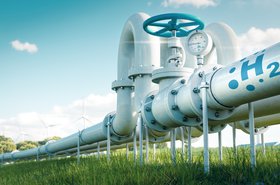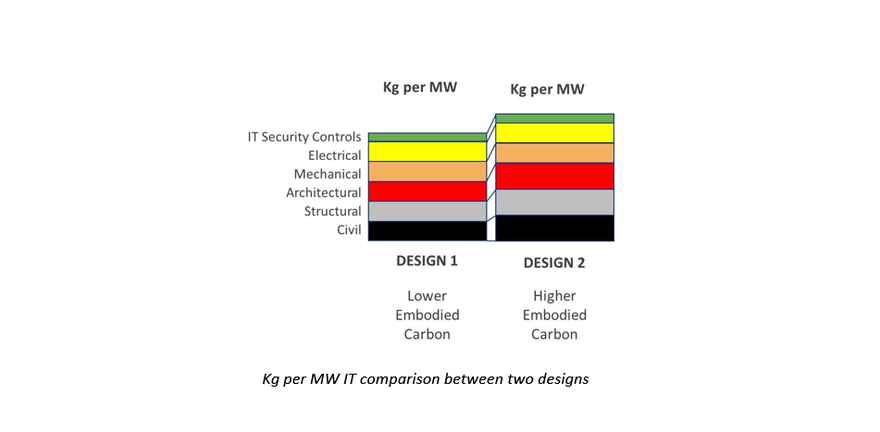RED Engineering Design – 100 percent part of Engie – is a global company of specialist building services and ICT engineers that has been driving towards the zero-carbon goal for over a decade through its step-change low-carbon solutions.
RED Engineering Design has now come up with an Embodied Carbon Calculator, enabling a more comprehensive evaluation of whole life cycle analysis (WLCA) in data center design processes.
WLCA encompasses all environmental impact of a product or service by capturing all embodied, operational, transport, construction and end of life emissions, expressing these as a normalized, equivalent CO2 figure.
The importance of embodied carbon
During the last ten years, data centers have made significant improvements in terms of sustainability and efficiency, although legacy data centers remain one of the biggest obstacles standing in the way of the industry reaching its net zero carbon objectives.
The majority of the data center industry has now pledged radical reduction of their carbon emissions, accelerating activities in support of their commitments. Achieving these goals against an ever-increasing demand for data services however appears to be tough.
New build data centers are undeniably more sustainable than legacy portfolios in terms of operational resource use. This makes embodied carbon within the construction phase a new key area to be addressed.
Early data center design was primarily focused on cost, resiliency and uptime, but later evolved to include efficiency and the reduction of operational energy consumption. The economic approach to design decision-making has considered the data center lifecycle, but only in terms of capital and operational expense and total cost of ownership.
Increasing the efficiency of the data center or reducing the resources required to build it lessens the GHG impact but there are limitations. If embodied carbon emissions are not considered, there remains the risk of design decisions having unintended – potentially environmentally detrimental – consequences.
Embodied carbon includes all emissions not attributed to operations and the use of electrical energy and water in the day to day running of a data center. These include emissions from extraction, manufacturing, transportation, as well as installation of materials and components used to create the built environment.
It also includes the lifetime emissions from in-use activities including maintenance, repair, replacement and the end-of-life activities of deconstruction, transportation, waste processing and disposal. WLCA therefore sums all greenhouse gas emissions to arrive at a normalized equivalent CO2 number.
With the continuous improvement of PUE measurements, great efforts to improve efficiency and reduce energy use have slowed down carbon emissions during operations, even as data center demand continues to increase.
That said, reducing the operational energy of a facility is measured over time, and therefore future emission changes need to be considered carefully too.
Embodied carbon captures environmental impact up to the point the building is built. Indeed, one of the biggest causes of carbon emissions from data centers is the construction of the facilities themselves.
Traditional building techniques and materials are responsible for the emission of substantial carbon (alongside other greenhouse gases and pollutants), long before operations start. Yet, few ways to account for these emissions are available today.
Embodied Carbon Calculator by RED Engineering Design
Data center operators and users are increasingly concerned about the embodied carbon of their facilities. RED Engineering Design is now asked to measure and minimize the embodied carbon when designing a data center and make it part of the design decision-process.
In order to do so, the company has created an embodied carbon calculator tool, that is aimed at the calculation of mechanical, electrical and plumbing infrastructure typically found in data centers, both from a landlord and tenant perspective.
The core of the calculator is a compelling database, structured with CO2 emissions data for all components that go into building a data center.
Where possible, the components modeled in the tool incorporate the embodied carbon from the manufacturer’s Environmental Product Declaration (EPD) or equivalent environmental certification (such as Product Environmental Profile, PEP.)
When this certificate is not available, other third party verified information can be used such as UK CIBSE TM65 or equivalent. Ongoing collaboration between RED and CIBSE intends to improve both the database and the methodology of WLCA.
The calculator is recommended to be used for early concept design stage assessment. RED Engineering Design focuses on the embodied carbon throughout the whole lifecycle of a data center, to enable the creation of what if/comparison scenarios to identify the best technologies and best designs in terms of embodied carbon.
Similar to a PUE approach for energy efficiency comparison, RED Engineering Design is strongly promoting a set of best practice embodied carbon per MW IT approach as a single number for comparing the carbon efficiency of different designs.
Conclusion
RED Engineering Design and Engie support their customers in their path to achieve net zero carbon data center designs. This entails making embodied carbon part of the design decision-process, using the RED embodied carbon calculator and conducting comparative analysis to identify best design to reduce a facility’s carbon footprint up-front. Find out more about how RED Engineering Design and Engie can support you in your energy transition in their series of articles.
More from Engie and RED Engineering
-

Sponsored How to achieve zero water cooling for green data centers
Engie’s Benjamin Lépineux and RED Engineering’s Phil Reid demonstrate how to drastically reduce – or entirely eliminate – the water consumption of your data center
-

Sponsored RED Engineering Design: Introducing the future
Here RED Engineering Design documents its growth – from expanding its services and workforce, to a renewed focus on sustainability and diversity
-

Sponsored Hydrogen-powered data centers: Utopian dream or next big thing?
How hydrogen and derivatives form a key strategic element of the carbon-neutrality solution


